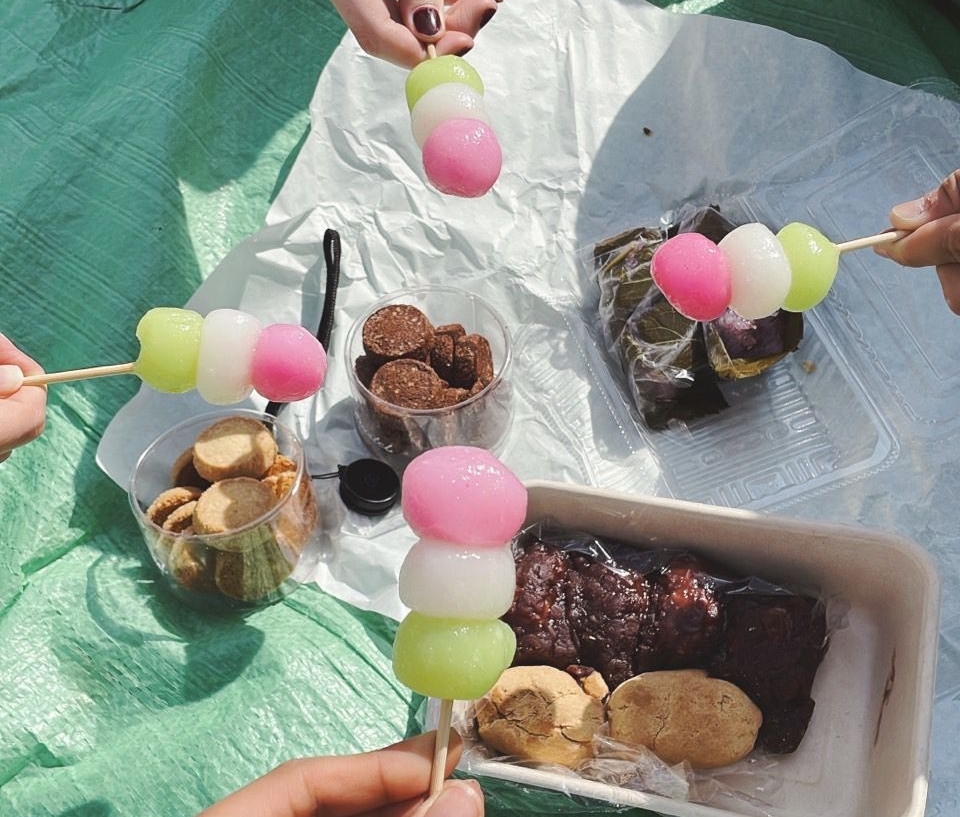Omiyage

Credit: Emma Claus
Licence: Creative Commons BY-NC-SA
2023
| Giver: | Individual |
|---|---|
| Receiver: | Individual or unstructured/informal group |
| Gift: | Items |
| Approach: | Other |
| Issues: | 16. Peace, Justice and Strong Institutions |
| Included in: | Gift Economies |
Omiyage refers to a tradition of Japanese giving wherein travelers bring back souvenirs – especially edible gifts – to family, friends and coworkers at home. Meant to evoke the distinct character of the travel destination, omiyage (literally “earth [local] produce”) are specially wrapped treats – such as candies, cookies, mini-cakes, rice crackers and liquor – that represent the meibutsu (or “famous product”) of that place. An act of generosity that is deeply embedded in Japanese etiquette, omiyage giving is an expression of respect and appreciation, a way for the traveler to show people who stayed home that they were always kept in mind, even while the traveler was away.
The practice of giving omiyage is believed to have developed centuries ago in association with religious pilgrimages to Shinto shrines and Buddhist temples. These long and often arduous journeys date back at least to the Heian era (785-1185 CE) – as depicted in The Tale of Genji, a classic work of Japanese literature written in the early 11th century by Murasaki Shikibu – and became increasingly popular during the Edo period (1600-1868).
Historically, pilgrims undertook their journeys not just for their own spiritual benefit but as chosen emissaries of their villages. The local community pooled their funds to provide senbetsu, a gift of money to subsidize the trip, with the expectation that the pilgrim would deliver prayers to the sacred site on their behalf. In return, the pilgrim brought home miyage (“souvenir”) paper amulets representing blessings from the shrine or temple.
Over time, as improvements in transportation infrastructure brought more and more visitors to sacred sites, the surrounding shops began to market local products as miyage. The addition of the honorific prefix “o” (omiyage) further emphasized notions of politeness and respect associated with these gifts.
In modern Japan, omiyage are almost always food items, distinctively packaged to augment their presentation as gifts, with individually wrapped portions that make them ideal for sharing. Each of the country’s 47 prefectures offers signature omiyage that highlight some aspect of local identity. Tokyo Banana, a sweet, bite-sized banana-shaped sponge cake, is the official omiyage and most iconic souvenir from Tokyo. Hiroshima’s Miyajima Island is known for Momiji manju, sweet red bean paste-filled cakes in the shape of maple leaves, recalling the island’s spectacular autumn foliage. Hokkaido is famous for Shiroi Koibito — elegant biscuits sandwiching a layer of chocolate, made by the prefecture’s renowned Ishiya Confectionery.
In Japan, omiyage giving is a fundamental courtesy and an obligatory part of any travel experience, such that it is considered a _faux pa_s to return home from a trip empty-handed. In a culture that prizes formal gestures of thoughtfulness and respect toward others, this ritual generosity is an important way to build and maintain strong and harmonious social bonds.
Contributor: Erin Brown
| Source type | Full citation | Link (DOI or URL) |
|---|---|---|
| Publication |
A.R., Anjali. “Unearthing the Roots of Food Gifts in Japan: A Tradition or an Invented Tradition?” dialog 40 (2022): 238-250. |
https://dialog.puchd.ac.in/wp-content/uploads/2023/03/16.-Exchange-of-Food-Gifts-in-Japan-A-Tradition-or-An-Invented-Tradition-1.pdf |
| Publication |
Ashkenazi, Michael. “Omiyage: Constructed Memories and Reconstructed Travel in Japan,” in Food and the Memory: Proceedings of the Oxford Symposium on Food and Cookery, 2000, ed. Harlan Walker, 31-38. Devon, England: Prospect Books, 2001. |
1903018161 |
| Publication |
Baker, Lucy. “47 Prefectures, 47 Japanese Food Souvenirs: Japan’s Regional Omiyage.” ByFood.com (blog), July 21, 2022. |
https://www.byfood.com/blog/culture/japanese-food-souvenirs-regional-omiyage |
| Publication |
Bond, Taylor. “The Advent of Omiyage and its Transformation through Time.” Deeper Japan, January 9, 2024. |
https://deeperjapan.com/journal/the-advent-of-omiyage-and-its-transformation-through-time |
| Publication |
Tao. “Understanding Omiyage Culture in Japan.” Go! Go! Nihon (blog), June 1, 2021. |
http://gogonihon.com/en/blog/omiyage-culture-in-japan/ |